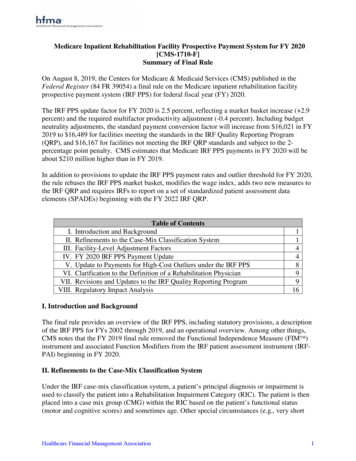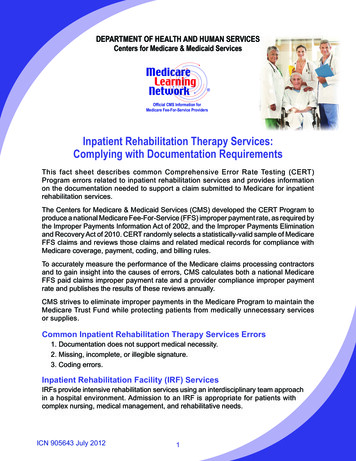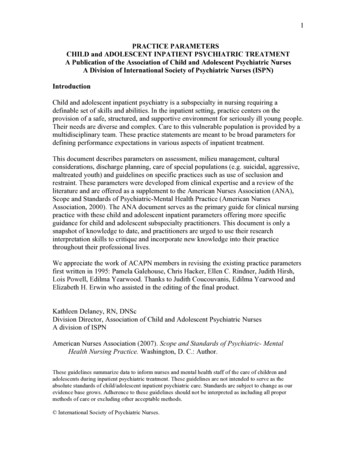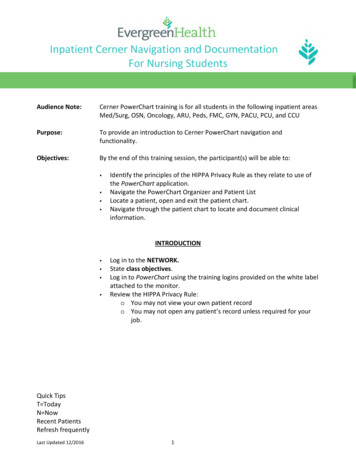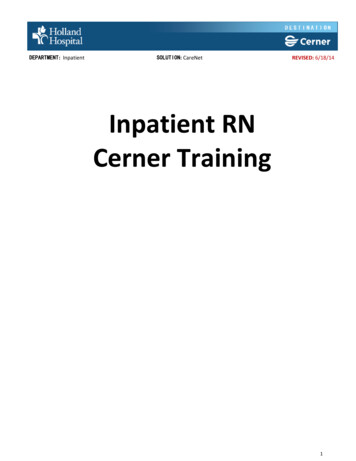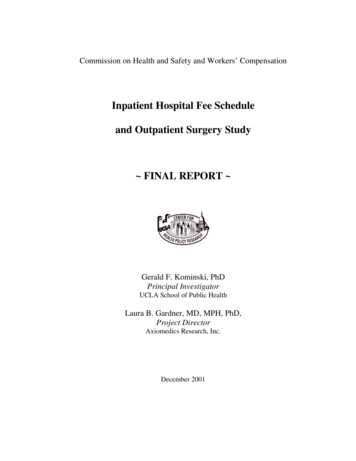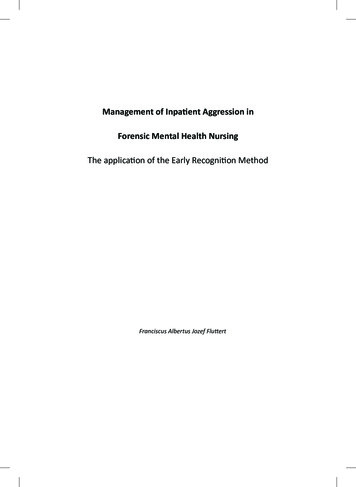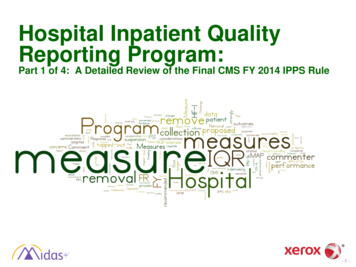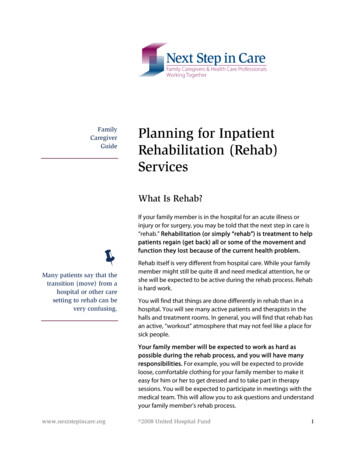
Transcription
FamilyCaregiverGuidePlanning for InpatientRehabilitation (Rehab)ServicesWhat Is Rehab?If your family member is in the hospital for an acute illness orinjury or for surgery, you may be told that the next step in care is“rehab.” Rehabilitation (or simply “rehab”) is treatment to helppatients regain (get back) all or some of the movement andfunction they lost because of the current health problem.Many patients say that thetransition (move) from ahospital or other caresetting to rehab can bevery confusing.Rehab itself is very different from hospital care. While your familymember might still be quite ill and need medical attention, he orshe will be expected to be active during the rehab process. Rehabis hard work.You will find that things are done differently in rehab than in ahospital. You will see many active patients and therapists in thehalls and treatment rooms. In general, you will find that rehab hasan active, “workout” atmosphere that may not feel like a place forsick people.Your family member will be expected to work as hard aspossible during the rehab process, and you will have manyresponsibilities. For example, you will be expected to provideloose, comfortable clothing for your family member to make iteasy for him or her to get dressed and to take part in therapysessions. You will be expected to participate in meetings with themedical team. This will allow you to ask questions and understandyour family member’s rehab process.www.nextstepincare.org 2008 United Hospital Fund1
Inpatient Rehab ServicesHere are five important points to remember:1. The goal of rehab is to help patients be independent —doing as much for themselves as they can.2. Rehab is done with a patient, not to a patient. Your familymember must be willing and able to work with rehabservices during active treatment and, later, with caregiversor by themselves at home.3. The patient’s chronic (long-term) health conditions, suchas high blood pressure or cholesterol, are treated duringrehab, but they are not the reason the patient is in rehab.4. Most rehab services last weeks, not months.5. Most insurance policies cover rehab when ordered by adoctor, but there will probably be extra costs.Where Are Rehab Services Provided?Patients can get rehab services at home, in a local clinic, or at aninpatient setting (either a rehab unit within a hospital, nursinghome, or a separate rehab facility).While this guide looks only at inpatient rehab services, rehabservices can be provided by a home health agency as a “skilledservice.” In this case, your family member must be well enough tobe at home. You may want to consider whether home careincluding rehab is an option for your relative. There are alsooutpatient rehab services. In this case, your family member mustbe able to travel back and forth to the clinic or hospital thatprovides rehab.www.nextstepincare.org 2008 United Hospital Fund2
Inpatient Rehab ServicesInpatient Rehab SettingsInpatient rehab can take place at any of these settings:Rehab unit within a hospital or a separate inpatient rehabfacility (IRF). These rehab programs are usually very intense.Patients must be able to benefit from, and receive, at leastthree hours of therapy five days each week. Some patients maybe admitted even though they are not able to tolerate anintense program at first if the therapists believe that thepatient will be able to improve quickly. If possible, talk withyour family member about whether this setting is right for hisor her needs. Think about his or her current illness as well asother chronic health problems. Check with your familymember’s doctor and physical therapist about this level ofrehab.Rehab unit within a skilled nursing Facility (SNF)—alsocalled a nursing home. Most patients who are discharged torehab go to a SNF (pronounced like “sniff”). These programsoffer the same types of services as an IRF but at a less intenselevel. Rehab services at a SNF are not the same as long-termcare in a nursing home. Indeed, most patients at a SNF aredischarged home when rehab is over. Some patients do moveto the regular long-term care part of a SNF, however, so youshould be aware of this possibility.Special settings. Some types of rehab take place in specialsettings such as brain injury units or cardiac (heart) units. Askhospital staff if this is an option you and your family membershould consider.www.nextstepincare.org 2008 United Hospital Fund3
Inpatient Rehab ServicesMaking a Choice about SettingsA discharge planner inthe hospital (usually anurse or social worker)will provide a list of rehabsettings appropriate foryour family member. Youand your family memberwill be asked to chooseup to five places whereyou are willing to go.When there is an openbed at any of thesesettings and your familymember is well enough toleave the hospital, youwill be asked to acceptthis placement and leavethe hospital. You will nothave much time—anotherreason you shouldbe prepared.The hospital treatment team may suggest that your familymember go to rehab after leaving the hospital. (Sometimes staffmembers will say “go to a nursing home” when what they reallymean is going to a rehab unit in a SNF.)Rehab settings are different from hospitals. They decide whichpatients they accept on the basis of whether the person canbenefit from the level and kind of services they provide. So, evenif you decide, for example, that your family member would like tohave rehab in an IRF, the IRF may not be willing to accept him orher.Here are some things to think about when making a choiceabout rehab setting:Amount of services. Some rehab settings are more intenseand active than others. Think about your family member’scurrent health problem as well as any chronic concerns. Talkabout these with your family member’s medical team to makethe best choice.Location. The ideal is to find a rehab setting near where youlive or work. This way, it is easy for you to visit. You might wantto go to therapy with your family member, learn how to helpyour family member do the exercises, find out how to get thehouse ready, help plan for discharge, or offer comfort andmoral support throughout the rehab process.Cost. Medicare, Medicaid, and most private health insuranceplans may pay all or some of the rehab costs. But there arestrict guidelines, and you need to pay all costs that insurancedoes not cover. It is important to learn as much as you can. Youcan do so by talking with the discharge planner or someone atthe financial office in the rehab facility.www.nextstepincare.org 2008 United Hospital Fund4
Inpatient Rehab ServicesRehab ServicesPatients often work with two or more rehab services. Theseinclude:Physical therapy (PT). This helps patients with problemsmoving, balancing, walking, and performing other activities.PT can also help patients with prosthetic (artificial) arms orlegs, shoe inserts, wheelchairs, walkers, and other assistivedevices.Occupational therapy (OT). This helps patients be moreindependent with self-care and other daily tasks, such aseating, getting dressed, typing, and using the telephone.Speech therapy. This helps patients relearn language skillssuch as talking, reading, and writing. It can also help withswallowing problems.Psychological counseling (or simply “counseling”). Thishelps patients (and sometimes also their family members)adjust to major life changes caused by an illness or injury.Counseling may be offered individually (one patient at a time)or in a group.Going from Hospital to Inpatient Rehabto HomeGoing from hospital to rehab. Hospital staff should tell therehab staff about what they did as treatment and care for yourfamily member.Clothing. Your family member will need to wear loose,comfortable clothes (not gowns) to participate in therapysessions (such as physical therapy or occupational therapy).The facility does not provide such clothing, so you will have tobring them from home or buy them. It is important to putlabels in the clothing and bring them to the rehab facility atthe time of admission. Make sure to ask the rehab team aboutthe facility’s specific policies about clothing.www.nextstepincare.org 2008 United Hospital Fund5
Inpatient Rehab ServicesInitial assessment for restorative potential. Rehab staff willassess your family member within two days of admission. Themost important finding is “restorative potential.” This meansthe level of function (ability to move or do activities) that yourfamily member is likely to regain from rehab. Restorativepotential has to do with only the current illness, and not anychronic condition, such as diabetes, arthritis, or dementia.Insurance pays for rehab only when your family member ismaking progress toward restorative potential.Going back to thehospital. During therehab stay, your familymember’s medicalcondition may change. Heor she may need to behospitalized. In thatevent, he or she may beable to return to the rehabsetting or a long-termplacement may be moreappropriate. Ask thesocial worker, or someoneat the financial officeabout the facility’s “bedhold” policy—the amountof time it will hold yourfamily member’s bedduring a hospital stay,and the financialresponsibility for holdingthe bed.www.nextstepincare.orgRehab begins. The amount of time your family memberspends in rehab depends on the type of setting. Staff willassess your family member throughout the rehab process tomake sure he or she is making progress toward restorativepotential.Care plan (“team”) meeting. This meeting takes place afterrehab has started. It includes staff from nursing, social services,dietary, recreation, and rehabilitation who discuss your familymember’s progress. You and your family member will be askedto attend. This is a good time to ask questions and raise anyconcerns.Discharge to home. Patients are discharged from rehab whenthe team assesses that they have reached a “plateau” (a timewhen the patient is not making any progress, but is notgetting any worse). This means that the patient is not likely tomake more progress. When your family member reaches aplateau, rehab staff will give you a written notice stating thatMedicare or other insurance will end on a certain date (oftenthe day after this notice is given). Speak up and let the staffknow if you feel that your family member needs more time.Rehab after discharge. Many patients continue their rehabafter leaving an inpatient setting. This can happen at home orin the community as an outpatient. Many patients feel muchbetter and improve quickly when they have returned to thecomforts of home. 2008 United Hospital Fund6
Inpatient Rehab ServicesFactors that Affect a Patient’sRehab ProgressTo repeat, rehab is hard work. Here are some factors that canaffect a patient’s progress:Patient motivation (how much a patient is willing to workat rehab). People differ when it comes to motivation. It candepend on a person’s illness, type of rehab, and restorativepotential. A person’s personality is also a factor; some peoplelike a challenge while others do better without pressure.Sometimes it is hard to know whether to respond with agentle or a firm approach. Praise is always good, even ifprogress seems slow. Caregivers can help by talking withrehab staff about how their family member has dealt withother life challenges.Relationships with therapists. Your family member will likelywork with many therapists. Of course, each has his or her ownstyle. Let each therapist know what style works best and askthat this information be written in the treatment plan.Expectations. One of the hardest parts of rehab is beingrealistic about how much function a patient can get back.Some patients make a full recovery and get back to the samelevel as before. Other patients improve just a little. You andyour family member may need to adjust expectations andlearn new ways of doing daily tasks.Feelings. Patients can have a lot of feelings during rehab.These can be feelings about the injury or illness itself, attitudesabout rehab and restorative potential, or expectations forrecovery. Feeling tired, angry, discouraged, or overwhelmed isnormal and part of the rehab process. Talk with the staff if youthink these feelings are so strong in your family member thatthey may affect the rehab progress. As a family caregiver whois watching or being part of the rehab process, you will alsohave many strong feelings. You may need someone to talk toas well. It may help to discuss these feelings with the socialworker, or ask the staff who can help you.www.nextstepincare.org 2008 United Hospital Fund7
Inpatient Rehab ServicesHow Family Caregivers Can HelpHave a good relationship with rehab staff. Talk with staffabout the rehab plan. Ask how your family member is doing intreatment. Speak up if you have concerns about the care yourfamily member is getting.Rehab is an importantpart of your familymember’s care andrecovery. To get the mostout of rehab, you andyour family membershould understand thegoals and limits of rehabservices, and work closelywith staff. Rehab is hardwork, but the results canbe well worth the effort.Encourage independence. The purpose of rehab is to helppatients be as independent as possible. You can help byencouraging your family member to do as much as he or shecan. This is a sign of love, not disrespect. It does not help to beoverprotective, which can slow a patient’s progress.Balance your need to know with your family member’swish for privacy. While some patients always want caregiverswith them, others prefer to have therapy sessions alone. Talkwith your family member about the right balance betweenthese options.Figure out when and how much to visit. While of course youwant to help your family member, you likely have other workor family responsibilities. Even if you can visit only in theevening, you can still talk with night staff or make anappointment to meet with staff another time.Find ways to help. This can be friendly visits, bringing picturesfrom home, going to care plan meetings, talking with staffabout discharge, going to rehab sessions, or working withthe therapists.Paying for Rehab ServicesInsurance coverage can be confusing. Your family member mayhave Medicaid, Medicare, private health insurance, or somecombination of these plans. Make sure you fully understand whatinsurance will and will not pay for. We strongly suggest that youlearn more by talking with the financial office at your familymember’s rehab facility.www.nextstepincare.org 2008 United Hospital Fund8
Inpatient Rehab ServicesHere are some basic facts about paying for rehab:Medicaid. Medicaid will pay for rehab if your family membermeets its strict guidelines about the type and amount of service. Ifyour family member is eligible for Medicaid but does not yet haveit, staff at the rehab setting can help you apply.Medicare. Medicare may or may not pay for rehab services from askilled nursing facility (SNF). To qualify, your family member must:Need skilled nursing care 7 days a week or skilled rehabservices 5 days a week. A doctor or nurse practitioner mustcertify that your family member needs these services.Have been in a hospital for at least 3 consecutive days (notcounting the discharge day) within the 30-day period beforegoing to a SNF.Be admitted to the SNF for the same illness or injury that wastreated in the hospital.Be assessed by rehab staff at least once a week to find outwhether he or she has reached restorative potential. Medicarestops paying for rehab services when patients reach this level.Medicare uses the term “benefit period” to define the time forrehab services. Here are some facts:A benefit period begins on the first day your family member isadmitted to a hospital or a SNF and continues for up to 100days. It ends when your family member has not receivedservices from a hospital or SNF for 60 days in a row.Medicare will assess staff reports of your family member’sprogress and stop paying for rehab services when he or shehas reached restorative potential. This may take less than 100days.You can appeal if Medicare says that it will no longer pay forrehab services. Understand that there is a lot of paperworkinvolved. To learn more about how to appeal a Medicaredecision, talk with the people at the financial office at therehab facility.Medicare puts no limits on the number of benefit periods apatient can have.www.nextstepincare.org 2008 United Hospital Fund9
Inpatient Rehab ServicesWhen Medicare pays for rehab services, it pays the full cost forthe first 20 days and part of the cost for the next 80. Yourfamily member or you will have to pay a co-insurance costduring these 80 days. This fee is set by Medicare and not therehab setting.Medicare and Medicaid. Some patients are “dually eligible”; thismeans they have Medicaid and Medicare at the same time. Whenthis happens, Medicaid pays for rehab services not coveredby Medicare.Private health insurance. Most health insurance plans follow thesame guidelines as Medicare, but may require more frequentassessments of the patient’s restorative potential. Talk with thehealth insurance company when your family member is admittedto rehab and throughout the course of care.Other CostsEven when Medicare or other insurance pays for all or most ofrehab, there may still be costs that you or your family member hasto pay. They may include:Private telephones, haircuts, and other personal careservices.Ambulance transportation. While Medicare or otherinsurance will pay for an ambulance to take your familymember from the hospital to an inpatient rehab facility, it maynot pay the costs of going elsewhere for other tests.Service after a patient reaches restorative potential. Somepatients need more time to reach their full potential. IfMedicare or other health insurance has ended, your familymember may have to move to another setting. Staff will assessyour family member to get a better idea of what services he orshe needs. You or your family member must pay all costs thatinsurance does not cover. This situation is quite common,especially with older adults. The good news is that your familymember is still making progress toward rehab goals.www.nextstepincare.org 2008 United Hospital Fund10
hospital for an acute illness or ily at things are done differently in rehab than in a s member will be expected to work as hard as y e Rehabilitation (Rehab) Services W. If your family member is in the injury or for surgery, you may be told that the next step in care is “rehab.” Rehabil
